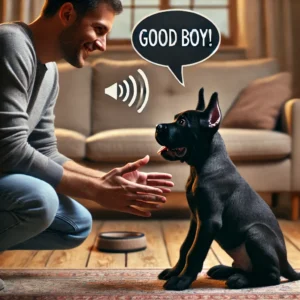
Incorporating basic obedience into your daily routine is essential for fostering a well-behaved, confident, and happy dog.
Consistent training not only teaches your puppy valuable skills but also strengthens your bond by building trust and communication.
Here’s why it’s important:
1. Establishes Boundaries and Structure:
Puppies thrive on routine and clear expectations. Incorporating basic commands like “sit,” “stay,” and “leave it” into everyday activities teaches them what behaviors are acceptable, creating a structured and predictable environment where they feel secure.
2. Encourages Good Manners:
By practicing commands like “wait” before meals or “heel” during walks, your puppy learns patience and self-control. These small daily interactions build habits that make them easier to manage at home and in public.
3. Stimulates Mental Engagement:
Obedience training challenges your puppy’s brain, keeping them mentally stimulated and reducing boredom. This can help prevent destructive behaviors, such as chewing or digging, that often arise from lack of mental exercise.
4. Reinforces Communication:
Daily practice of commands allows you to refine your communication with your puppy. Clear and consistent training strengthens their understanding of your cues and fosters cooperation.
5. Prepares for Real-Life Situations:
Teaching commands like “come” and “drop it” equips your puppy with life-saving skills. Practicing these commands regularly ensures they respond reliably in unexpected or dangerous situations.
6. Supports Positive Socialization:
Incorporating obedience into outings, such as practicing “stay” at a park or “down” at a café, helps your puppy remain calm and confident in new environments, making them more adaptable and well-mannered around people and other animals.
7. Builds a Stronger Bond:
Training sessions are an opportunity to spend quality time with your puppy. Positive reinforcement during these sessions fosters trust, deepens your connection, and boosts their confidence.
By incorporating obedience into your daily routine—whether through short training sessions, reinforcing commands during walks, or turning everyday interactions into teachable moments—you’ll create a foundation for a well-behaved companion who integrates seamlessly into your life.
10 Basic Obedience Commands to Teach Your Puppy
1. Sit – A foundational command for focus and calmness.
2. Stay – Helps your puppy learn patience and impulse control.
3. Come – Vital for safety and recall.
4. Down – Teaches your puppy to settle.
5. Leave It – Prevents them from grabbing unsafe items.
6. Drop It – Encourages them to release something they’ve picked up.
7. Heel – Ensures calm and controlled walking on a leash.
8. Wait – Teaches them to pause before proceeding (e.g., at doors).
9. Place – Helps them stay in a designated spot.
10. No – Sets boundaries and helps them understand unacceptable behavior.
By incorporating structured routines with rest, stimulation, and crate training, as well as teaching these foundational commands, you’ll set your puppy up for a lifetime of success and strengthen your bond as companions.